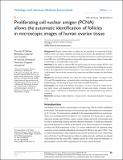Proliferating cell nuclear antigen (PCNA) allows the automatic identification of follicles in microscopic images of human ovarian tissue
Abstract
Background: Human ovarian reserve is defined by the population of nongrowing follicles (NGFs) in the ovary. Direct estimation of ovarian reserve involves the identification of NGFs in prepared ovarian tissue. Previous studies involving human tissue have used hematoxylin and eosin (HE) stain, with NGF populations estimated by human examination either of tissue under a microscope, or of images taken of this tissue. Methods: In this study we replaced HE with proliferating cell nuclear antigen (PCNA), and automated the identification and enumeration of NGFs that appear in the resulting microscopic images. We compared the automated estimates to those obtained by human experts, with the “gold standard” taken to be the average of the conservative and liberal estimates by three human experts. Results: The automated estimates were within 10% of the “gold standard”, for images at both 100× and 200× magnifications. Automated analysis took longer than human analysis for several hundred images, not allowing for breaks from analysis needed by humans. Conclusion: Our results both replicate and improve on those of previous studies involving rodent ovaries, and demonstrate the viability of large-scale studies of human ovarian reserve using a combination of immunohistochemistry and computational image analysis techniques.
Citation
Kelsey , T W , Caserta , B , Castillo , L , Wallace , W H B & Coppola , F 2010 , ' Proliferating cell nuclear antigen (PCNA) allows the automatic identification of follicles in microscopic images of human ovarian tissue ' , Journal of Pathology and Laboratory Medicine International , vol. 2010 , no. 2 , pp. 99-105 . https://doi.org/10.2147/PLMI.S11116
Publication
Journal of Pathology and Laboratory Medicine International
Status
Peer reviewed
Type
Journal article
Description
TWK is supported by EPSRC grants EP/CS23229/1 and EP/H004092/1.Collections
Items in the St Andrews Research Repository are protected by copyright, with all rights reserved, unless otherwise indicated.

